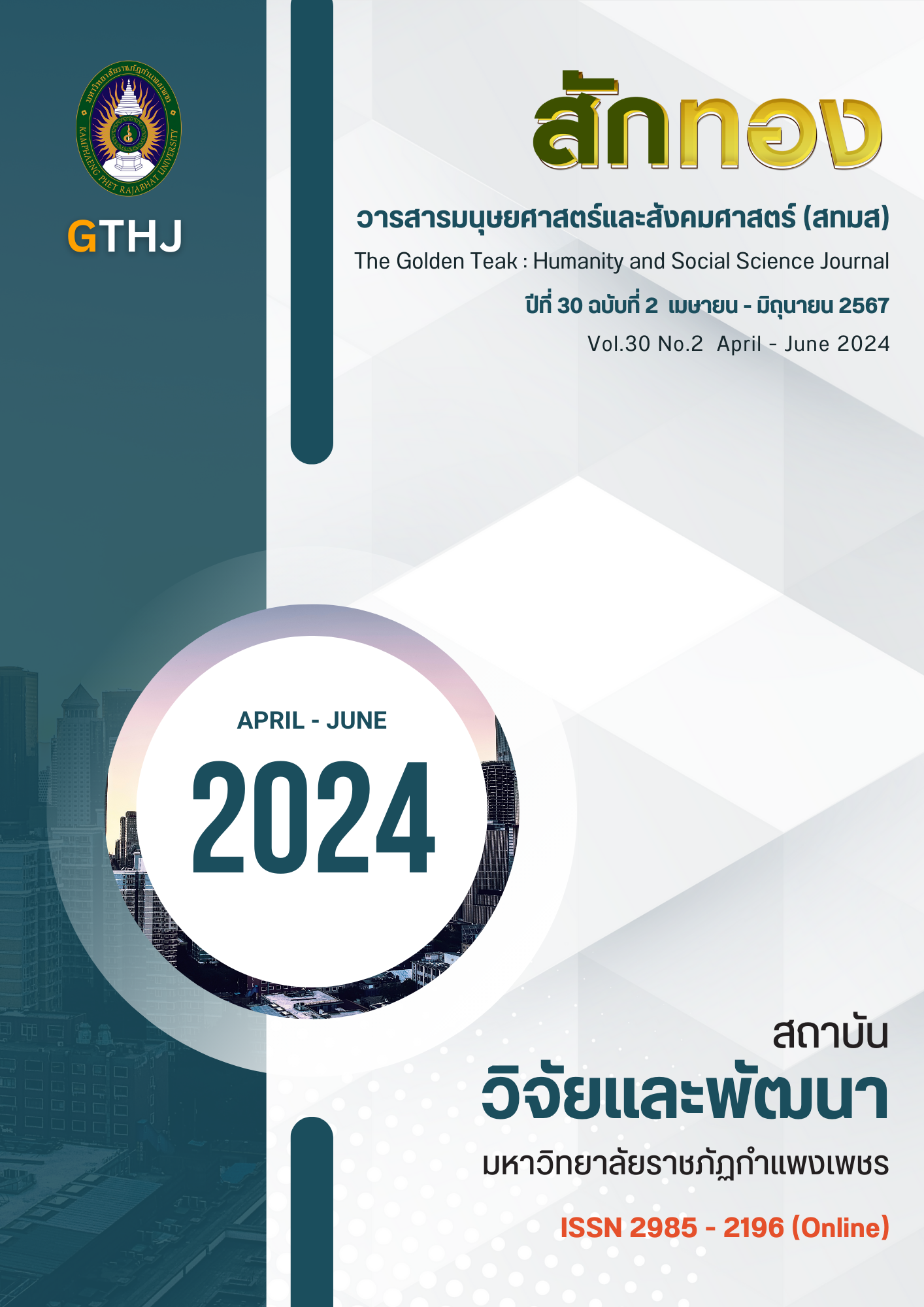The Semiological Meaning of Villagers’ ways of Life in Mural Paintings in Mahasarakham Province
Main Article Content
Abstract
This article is a part of a doctor of philosophy dissertation on the semiological meaning of villagers’ ways of life in mural paintings in Mahasarakham Province. It aimed at finding semiological meaning of ways of life appearing in the murals in Mahasarakham Province by qualitative study. The tools used in this study were observation, interview and focus group discussion by using 188 painting population which had been studied and then they were brought to discuss for semiological meaning by ten representatives of local people in the community and three experts. The murals were divided into three groups: family's way of life, community way of life and physical environment pictures. Then all the murals were analyzed again and 129 murals were selected and divided into two groups: family's way of life and community way of life. Then the purposive sampling method was used to select the population which comprised two murals for each group. Then they were analyzed by semiology theory of Roland Barthes for denotative and connotative meanings. The results showed that the murals could replace the truth and could convey to the new context. There were two levels of conveying meanings: the denotative meaning and connotative meaning. The denotative meaning was the meaning of the semiological signs which the artists intended to directly communicate the literature through the murals. The connotative meaning showed that the artists inserted semiological meaning into the murals of community way of life and the literature harmoniously which reflected that the community way of life was built by the people in the society. They revealed the good virtues of the society. In the aspect of the community background, the murals recorded their own community way of life which reflected that the value of arts, community background, society, economy, principles and beliefs were hidden in semiological signs. This study helped discover way of reading pictures and the new way of interpretation which helped learn the meaning in the pictures leading to better the atmosphere of viewing pictures.
Article Details

This work is licensed under a Creative Commons Attribution-NonCommercial-NoDerivatives 4.0 International License.
บทความที่ได้รับการตีพิมพ์เป็นลิขสิทธิ์ของวารสาร สักทอง : วารสารมนุษยศาสตร์และสังคมศาสตร์ สถาบันวิจัยและพัฒนา มหาวิทยาลับราชภัฏกำแพงเพชร
ข้อคิดเห็นใดๆ ที่ปรากฎในวารสารเป็นวรรณกรรมของผู้เขียนโดยเฉพาะ ซึ่งมหาวิทยาลัยราชภัฏกำแพงเพชรและบรรณาธิการไม่จำเป็นต้องเห็นด้วย
References
Boonkham, P. (2014, February 15). A villager of Banyang Village, Yang Subdistrict, Borabue District, Mahasarakham Province. Interview. [In Thai]
Chaiya, K. (2019, July). Roland Barthes’s Fundamental Concept of Semiology. Journal of Humanities and Social Sciences, 7(2), 28-30.
Charernsin-olarn, Ch. (2012). Semiology, Structuralism, Post-Structuralism and The Study of Political Science. (2 nd ed). Bangkok : Wipasa Press. [In Thai]
Kaewthep, K. (1999). Media Analysis Concepts and Techniques. Bangkok : Edison Press Products. [In Thai]
Kaewthep, K. (2012). Old Medias-New Medias : Semiology, Identity, Ideology. Bangkok : Thailand Research Fund (TRF). [In Thai]
Kanlayanatam Club. (2006). The Biography of Phra Ajarn Mun Puritatto and Muttotthai. Bangkok : Kornmek and Kun Group. [In Thai]
Namwiset, J. (2018, November 11). A villager of Dongbang Village, Dongbang Subdistrict, Nadoon District, Mahasarakham Province. Interview. [In Thai]
Nantadeelok, P. (1998). Mural Paintings of Vessantara Jataka at Sim, Banyang Temple, Yang Subdistrict, Borabue District, Mahasarakham Province. Mahasarakham : Mahasarakham University. [In Thai]
Pattanopart, T. (2008). Semiotics and Pictures Replacing Meanings. [Online]. Available : https://www.arch.chula.ac.th/journal/files/article/qyYaZ1mab3Sun103124.pdf [2018, May 11]. [In Thai]
Prachakun, N. (2008). “Roland Barthes and Semiotics Literature” in Mythologies of Roland Barthes. Translated from French by Wanwimon Ankkasirisup. (2 nd ed.). Bangkok : Kopfai Press. [In Thai]
Raksachart, S. (2018, August 15). A villager of Banyangmai Village, Yang Subdistrict, Borabue District, Mahasarakham Province. Interview. [In Thai]
Suppayasarn, P. (2007). Development of Isan Society during 24th- 25th Buddhist Centuries. Bangkok : The National Research Council of Thailand. [In Thai]


